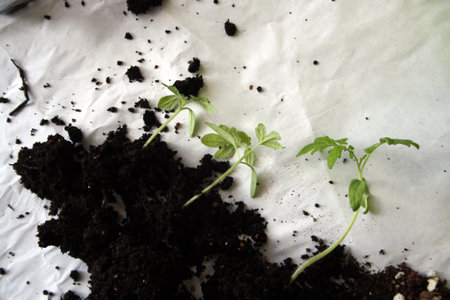1. Understanding Soil Fungi: The Basics
Soil is more than just dirt—its a living, breathing ecosystem filled with organisms that play essential roles in plant health. One of the most important (and sometimes misunderstood) members of this underground community are fungi. Not all fungi are bad; in fact, many are vital to your garden’s success. Let’s break down the major types of fungi you’ll find in soil and what they do.
Major Types of Soil Fungi
There are thousands of species of fungi in the soil, but when it comes to gardening and farming, they generally fall into two main categories: mycorrhizal fungi (the good guys) and pathogenic fungi (the troublemakers).
| Type of Fungi | Description | Role in Soil |
|---|---|---|
| Mycorrhizal Fungi | Form symbiotic relationships with plant roots | Help plants absorb water and nutrients, especially phosphorus; improve soil structure |
| Pathogenic Fungi | Cause diseases in plants by attacking roots or other tissues | Lead to plant stress, root rot, wilting, and sometimes death |
What Are Mycorrhizal Fungi?
Mycorrhizal fungi are like friendly neighbors who help you out without asking for much in return. These fungi attach themselves to plant roots and expand the root system through a network called mycelium. In exchange for sugars from the plant, they bring back water and nutrients from deep within the soil. This relationship boosts plant health and resilience.
Two Common Types:
- Endomycorrhizae: Penetrate plant root cells; common in vegetables, grasses, and shrubs.
- Ectomycorrhizae: Surround root cells but dont enter them; often found with trees like pines and oaks.
What Are Pathogenic Fungi?
On the flip side, pathogenic fungi are more like uninvited guests who wreak havoc on your property. These harmful fungi can cause a range of plant diseases, such as damping-off in seedlings or root rot in mature plants. They thrive in poorly drained soils or where plants are stressed from lack of nutrients or overcrowding.
Common Examples:
- Pythium: Causes damping-off disease in young plants.
- Fusarium: Leads to wilt diseases in tomatoes, peppers, and other crops.
- Rhizoctonia: Affects root systems and lower stems of various plants.
The Key Difference: Friend or Foe?
The biggest difference between these two types of fungi is their impact on your garden. Mycorrhizal fungi support healthy growth, while pathogenic fungi do the opposite. Knowing how to encourage beneficial fungi while limiting harmful ones is key to maintaining a thriving garden ecosystem.
2. Mycorrhizal Fungi: Nature’s Underground Network
When it comes to healthy soil, mycorrhizal fungi are the unsung heroes. These beneficial fungi form a symbiotic relationship with plant roots, creating a natural underground network that helps plants thrive. Unlike harmful pathogens, mycorrhizal fungi work with your plants—not against them.
What Are Mycorrhizal Fungi?
Mycorrhizal fungi are microscopic organisms that attach to plant roots and extend far into the soil. They act like an extension of the root system, allowing plants to access nutrients and water more efficiently than they could on their own.
How Do They Help Your Plants?
This partnership is a win-win: the plant provides sugars and carbohydrates to the fungi, and in return, the fungi help the plant absorb essential nutrients like phosphorus, nitrogen, and trace minerals. Plus, this relationship can make your plants more resistant to drought and certain soil-borne diseases.
Benefits of Mycorrhizal Fungi
| Benefit | Description |
|---|---|
| Improved Nutrient Uptake | Fungi expand the reach of roots, helping plants absorb more phosphorus, nitrogen, and micronutrients. |
| Drought Resistance | The fungal network retains moisture around the root zone, helping plants survive dry spells. |
| Soil Health | Fungi improve soil structure by forming stable aggregates that promote aeration and water retention. |
| Disease Protection | A stronger root system is less susceptible to soil pathogens and root rot. |
Where Can You Find Them?
You can encourage mycorrhizal fungi naturally by avoiding overuse of synthetic fertilizers and tilling less often. Theyre especially common in native soils but can be added through commercial inoculants if your garden needs a boost.
Quick Tip:
If youre planting new trees or perennials, try using a mycorrhizal inoculant at planting time. It’s an easy way to give your plants a strong start!
![]()
3. Pathogenic Fungi: Silent Threats Beneath the Surface
While mycorrhizal fungi act as helpful partners in your garden, not all fungi are friendly. Some work against your plants, causing disease and decay from below the surface. These harmful organisms are known as pathogenic fungi, and they can quietly attack roots, stems, and even seeds—often before you notice anything is wrong above ground.
What Are Pathogenic Fungi?
Pathogenic fungi are microorganisms that infect plants and cause diseases. They live in the soil and thrive in moist, compacted, or poorly drained environments. Once they invade a plant’s root system, they can block water and nutrient uptake, eventually leading to stunted growth or plant death.
Common Soil-Borne Fungal Pathogens
Here are some of the most common soil-borne fungal pathogens that gardeners in the U.S. might encounter:
| Fungus | Common Symptoms | Affected Plants |
|---|---|---|
| Fusarium | Yellowing leaves, wilting, root rot | Tomatoes, peppers, beans |
| Pythium | Damping-off in seedlings, root decay | Lettuce, cucumbers, ornamentals |
| Rhizoctonia | Stem cankers, seedling collapse, poor germination | Carrots, beets, turfgrass |
How Do These Fungi Spread?
These pathogens can spread through contaminated soil, water, tools, or even shoes. Overwatering and poor drainage create the perfect conditions for them to thrive. Unlike pests you can see crawling on leaves or stems, these fungal invaders do their damage underground—making them harder to detect early on.
Pro Tip:
If you’ve had problems with damping-off in your seedlings or unexplained wilting in mature plants despite good watering habits, it could be a sign of pathogenic fungi at work in your soil.
The Battle Below Ground
The presence of harmful fungi doesnt always mean disaster—but it does highlight how important healthy soil biology is. A balanced soil ecosystem with beneficial microbes like mycorrhizal fungi can help suppress these pathogens naturally. That’s why understanding who’s living beneath your feet is key to growing strong, resilient plants.
4. Spotting the Difference: Signs and Symptoms
Understanding whether the fungi in your soil are helping or harming your plants can feel like a mystery, but there are some clear signs to look for. Mycorrhizal fungi and pathogenic fungi behave very differently, and your plants will show you whats going on beneath the surface.
How Mycorrhizal Fungi Help Your Plants
When beneficial mycorrhizal fungi are at work, youll see signs of healthy plant growth. These fungi form symbiotic relationships with plant roots, extending their reach for water and nutrients—especially phosphorus. Here’s what to look for:
Signs of Beneficial Fungal Activity
- Vigorous growth and lush foliage
- Improved drought resistance
- More blooms or fruits than usual
- Healthy, well-branched root systems
- Plants thriving even in poor soil conditions
Red Flags: When Pathogenic Fungi Are Present
Pathogenic fungi, on the other hand, attack plant roots and cause disease. They often strike when soil is poorly drained or compacted. Here are common symptoms that might indicate a fungal problem:
Signs of Harmful Fungal Activity
- Yellowing or wilting leaves despite adequate watering
- Stunted growth or sudden decline in health
- Soft, brown, or blackened roots (root rot)
- Mushy stems near the soil line (damping-off in seedlings)
- Moldy or fuzzy growth around the base of the plant
Quick Comparison Table: Good vs. Bad Fungi Symptoms
| Beneficial Mycorrhizal Fungi | Harmful Pathogenic Fungi |
|---|---|
| Lush, green foliage | Yellowing or wilting leaves |
| Robust root development | Black, mushy roots (root rot) |
| Drought tolerance improves | Poor response to watering |
| Better nutrient uptake and plant vigor | Stunted growth and weak stems |
| No visible mold or decay at soil level | Moldy growth at base or on soil surface |
Tip: Check the Roots!
If youre unsure which type of fungus is present, gently dig up one of your affected plants and inspect the roots. Healthy roots should be firm and white to light tan. If they’re dark, slimy, or smell bad, there’s a good chance pathogenic fungi are causing trouble.
Avoid Misdiagnosis
Poor plant health isnt always caused by bad fungi—it could also be due to pests, nutrient deficiencies, or environmental stress. That’s why it’s important to observe multiple signs before jumping to conclusions.
The more time you spend observing your garden’s behavior, the easier it becomes to spot these differences early—and take action when needed.
5. Cultivating the Good, Combating the Bad
In every healthy garden, theres a balance between helpful organisms like mycorrhizal fungi and harmful ones like soil-borne pathogens. Knowing how to support the good fungi while keeping the bad ones in check can make all the difference in your gardens health and productivity.
Encouraging Mycorrhizal Fungi Growth
Mycorrhizal fungi form symbiotic relationships with plant roots, helping them absorb water and nutrients—especially phosphorus—more efficiently. Heres how you can promote their presence in your soil:
Best Practices for Supporting Beneficial Fungi
| Practice | Why It Works |
|---|---|
| Avoid Over-Tilling | Tilling disrupts fungal networks that connect plant roots. |
| Limit Synthetic Fertilizers | High phosphorus fertilizers reduce the need for mycorrhizal help, discouraging their growth. |
| Add Organic Matter | Compost and mulch feed soil microbes and create a favorable environment for beneficial fungi. |
| Use Mycorrhizal Inoculants | These products introduce beneficial spores directly into your soil or onto plant roots. |
| Plant Diverse Species | Diverse root systems support different types of mycorrhizae, improving overall soil health. |
Preventing and Managing Soil-Borne Diseases
While youre encouraging the “good guys,” youll also want to keep an eye out for pathogenic fungi that cause root rot, damping-off, and other issues. Heres how to manage them:
Smart Gardening Tips to Reduce Pathogens
- Rotate Crops: Changing what you grow each season prevents disease buildup in the soil.
- Avoid Overwatering: Wet conditions favor fungal diseases. Water early in the day and only when needed.
- Improve Drainage: Raised beds or amended soils prevent water from pooling around roots.
- Sterilize Tools: Clean shovels, pruners, and pots to avoid spreading fungal spores.
- Select Disease-Resistant Varieties: Choose plants bred to resist common soil pathogens in your region.
A Quick Comparison: Mycorrhizal vs. Pathogenic Fungi
| Mycorrhizal Fungi | Pathogenic Fungi | |
|---|---|---|
| Effect on Plants | Boosts growth & nutrient uptake | Causes disease & root damage |
| Relationship Type | Mutualistic (beneficial) | Parasitic (harmful) |
| Preferred Conditions | Diverse, organic-rich soils | Poor drainage, overwatering |
Cultivating a garden that supports mycorrhizal fungi while minimizing pathogenic threats is all about balance. With these simple practices, youll be setting up your plants—and your soil—for long-term success.


